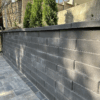A complete guide to costs, durability, design options, wall parts, and mistakes to avoid
Retaining walls aren’t just about holding back soil—they can transform your yard, add usable space, and protect your property from erosion. Whether you’re adding one for functionality, curb appeal, or both, it’s worth knowing the basics before you get started.
This guide covers the most common questions homeowners have—from costs and materials to the “1/3 rule” and common mistakes to avoid—so you can make confident decisions and get a wall that lasts.
1. How Much Does a Retaining Wall Cost?
 Retaining wall costs can vary widely depending on size, materials, and site conditions.
Retaining wall costs can vary widely depending on size, materials, and site conditions.
Main factors that affect price:
- Material choice – Engineered stone, natural stone, concrete blocks, and timber all have different price points.
- Wall height & length – Taller walls require more materials, engineering, and labor.
- Site prep – Excavation, grading, and dealing with poor soil conditions can add cost.
- Drainage solutions – Proper drainage is essential and may require extra installation steps.
Pro Tip: DIY might seem cheaper, but mistakes in design or drainage can lead to costly repairs later. Professional installation is often more cost-effective in the long run.
2. Which Materials Are Most Durable?
 Choosing the right material is key for both longevity and style.
Choosing the right material is key for both longevity and style.
- Engineered Stone – Designed for strength, consistent size, and easy stacking. Ideal for modern and classic looks.
- Natural Stone – Timeless and extremely durable, but usually higher cost.
- Concrete Block (Segmental) – Uniform size, versatile, and strong.
- Timber – Warm, natural look, more affordable, but shorter lifespan than stone or concrete.
✅ For Kansas City’s climate, engineered stone and concrete block hold up best to freeze-thaw cycles while offering a polished appearance.
3. Understanding the Parts of a Retaining Wall
 Knowing the wall’s anatomy helps you plan better:
Knowing the wall’s anatomy helps you plan better:
- Base/Foundation – Compacted gravel or crushed stone to provide stability.
- Wall Units – Engineered stone blocks or other materials stacked to form the main structure.
- Top Cap – Decorative and functional piece that finishes the wall and keeps units in place.
- Backfill – Soil behind the wall, often mixed with gravel for drainage.
- Drainage Pipe – Hidden behind the wall to prevent water pressure buildup.
- Geogrid (for taller walls) – Reinforcement layers inserted between courses for added stability.
4. What Is the “1/3 Rule”?
The 1/3 rule is a general guideline for stability:
- About 1/3 of the wall’s total height should be buried below ground.
- This helps the wall resist the pressure from soil and moisture behind it.
Example: A 6-foot retaining wall should have about 2 feet underground. Skipping this step is one of the most common causes of wall failure.
5. Common Mistakes to Avoid
 Even a beautiful retaining wall can fail if not built correctly. Watch out for these pitfalls:
Even a beautiful retaining wall can fail if not built correctly. Watch out for these pitfalls:
- Poor Drainage – Without proper backfill and drainage pipes, water pressure can push your wall over time.
- No Reinforcement – Taller walls often need geogrid or tiebacks to stay secure.
- Weak Base Preparation – A strong foundation of compacted gravel is crucial.
- Wrong Materials for the Height – Not all blocks or stones are designed for tall walls.
- Ignoring Permits or Codes – Many cities require permits for walls over a certain height.
6. Design & Functionality Options
Your retaining wall can be more than just a structural element—it can become a standout feature in your landscape.
 Popular options include:
Popular options include:
- Tiered Walls – Create planting spaces or a more gradual slope.
- Built-in Seating – Great for patios and fire pit areas.
- Integrated Lighting – Adds ambiance and safety.
- Plantable Walls – Allow greenery to cascade for a softer look.
At Envision Lawn and Tree, we can match the wall’s style to your home, choose materials that fit your budget and climate, and incorporate features that make it both beautiful and functional.
The Bottom Line
 A retaining wall is an investment that can protect your property and boost its visual appeal for years to come—if it’s built right. By understanding costs, materials, proper construction techniques, the wall’s parts, and design possibilities, you’ll be ready to make the best choice for your home.
A retaining wall is an investment that can protect your property and boost its visual appeal for years to come—if it’s built right. By understanding costs, materials, proper construction techniques, the wall’s parts, and design possibilities, you’ll be ready to make the best choice for your home.
Ready to start your retaining wall project?
Our team at Envision Lawn and Tree specializes in designing and installing walls that are as strong as they are stunning. Contact us today for a consultation and let’s create something that lasts.












